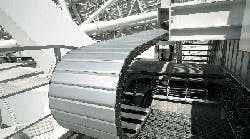When scientists want to look into the far corners of space, they rely on sophisticated instruments that collect tiny amounts of energy at various wavelengths along the electromagnetic spectrum. One such tool is the Effelsberg radio telescope, operated by the Max Planck Institute for Radio Astronomy in Bonn, Germany. Its massive dish gives astronomers a clearer view of such celestial wonders as neutron stars, black holes, and supernovae explosions.
Like most modern facilities, the Effelsberg telescope incorporates a network of electrical and electronic devices. Keeping everything connected is a challenge because of the relative motion throughout the site.
Several years ago, designers installed cable carrier systems that run from the connecting surface of the radio telescope’s concrete foundation to its parabolic reflector. The carriers supply two signal receiver cabins with electrical power, control data, and cooling water; they also support the transfer of measurement data. For several years, three carriers were in operation — two in a vertical arrangement and a third running horizontally on top of the machine case of an elevator drive. Today, five cable carrier systems are in place, the largest of which are manufactured by KabelSchlepp America Inc., Milwaukee, Wis.
Years ago, engineers decided to use an open style, stainless steel carrier to protect the cables. Due to the large number of cables and hoses, as well as serious space constraints, the design required two nested carrier systems. In all, the system houses 40 cables — 10 for power supply and 30 for control technology — plus eight hoses that supply glycol cooling water. The outer carrier contains electrical power cables and hoses, while the inner carrier holds data cables.
More recently, designers installed a new receiver system in the primary mirror, which requires considerably more data cables. They also installed a new secondary mirror that lets each segment rotate separately to balance out the primary mirror’s gravity-related errors. The additional power and control cables made it necessary to add two new cable carriers.
Based on previous experience, KabelSchlepp was selected to supply a nested stainless steel carrier system. This time, an enclosed version was specified with aluminum covers to shield cables from UV radiation and ice damage. With the old, open-style carrier, cables were replaced every 15 to 20 years, since jackets became brittle from UV radiation. The new covers offer complete protection and can be easily removed for system maintenance or expansion. For more information, visit www.kabelschlepp.com.
Dynamic dimensions
Primary mirror diameter: 100 m Secondary mirror diameter: 6.5 m Telescope weight: 3,200 ton Tilting: Primary mirror can be tilted between 7° and 94° degrees
